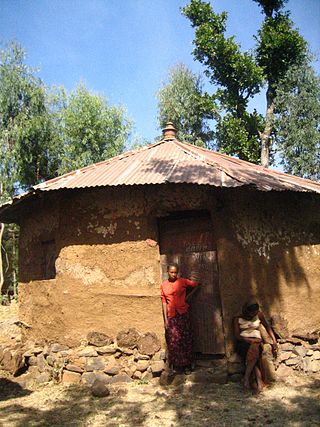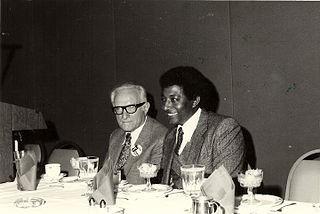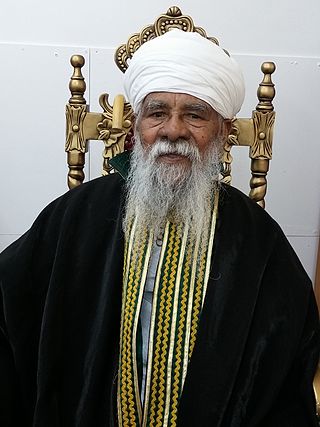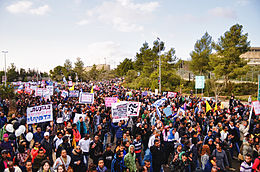
The Jewish Agency for Israel, formerly known as the Jewish Agency for Palestine, is the largest Jewish non-profit organization in the world. It was established in 1929 as the operative branch of the World Zionist Organization (WZO).

Aliyah is the immigration of Jews from the diaspora to, historically, the geographical Land of Israel or the Palestine region, which is today chiefly represented by the State of Israel. Traditionally described as "the act of going up", moving to the Land of Israel or "making aliyah" is one of the most basic tenets of Zionism. The opposite action — emigration by Jews from the Land of Israel — is referred to in the Hebrew language as yerida. The Law of Return that was passed by the Israeli parliament in 1950 gives all diaspora Jews, as well as their children and grandchildren, the right to relocate to Israel and acquire Israeli citizenship on the basis of connecting to their Jewish identity.
Operation Moses was the covert evacuation of Ethiopian Jews from Sudan during a civil war that caused a famine in 1984. Originally called Gur Aryeh Yehuda by Israelis, the United Jewish Appeal changed the name to "Operation Moses".

The Beta Israel, also known as Ethiopian Jews, are a Jewish community that lived for centuries in the area of the Kingdom of Aksum and the Ethiopian Empire, which is currently divided between the modern-day Amhara and Tigray regions of Ethiopia. Most of the Beta Israel community immigrated to Israel in the late 20th century.

Falash Mura is the name given to descendants of the Beta Israel community in Ethiopia who converted to Christianity, primarily as a consequence of Western proselytization during the late 19th and early 20th centuries. This term also includes Beta Israel who did not adhere to any Ethiopian Jewish practices, as well as the aforementioned historical converts to Christianity. While most voluntarily converted, some were also forcibly converted against their will, or felt compelled to convert due to economic hardship and social exclusion in a majority Christian population.
Operation Joshua, also known as Operation Sheba, was the 1985 airlifting of Ethiopian Jews from refugee camps in Sudan to Israel.

Operation Solomon was a covert Israeli military operation from May 24 to 25, 1991, to airlift Ethiopian Jews to Israel. Non-stop flights of 35 Israeli aircraft, including Israeli Air Force C-130s and El Al Boeing 747s, transported 14,325 Ethiopian Jews to Israel in 36 hours. One of the aircraft, an El Al 747, carried at least 1,088 people, including two babies who were born on the flight, and holds the world record for the most passengers on an aircraft. Eight children were born during the airlift process.

Graenum Berger (1908–1999) was an American Communal administrator, institutional and communal planner, educator, world traveler, and the founding President of the American Association for Ethiopian Jews.
Sigd, also Mehlella or Amata Saww, is one of the unique holidays of the Beta Israel community, and is celebrated on the 29th of the Hebrew month of Marcheshvan. Since 2008, it has been an official Israeli state holiday.

Religion in Ethiopia consists of a number of faiths. Among these mainly Abrahamic religions, the most numerous is Christianity totaling at 67.3%, followed by Islam at 31.3%. There is also a longstanding but small Ethiopian Jewish community. Some adherents of the Baháʼí Faith likewise exist in a number of urban and rural areas. Additionally, there is also a substantial population of the adherents of traditional faiths.

Yona Bogale was an Ethiopian Jewish educator and public figure, who served as the director of the Beta Israel education network in Ethiopia and worked vigorously for the immigration of Ethiopian Jews to Israel. He led the efforts to improve the living conditions of the Beta Israel in Ethiopia by expanding education, providing medical facilities, increasing agricultural production and promoting religious freedom. His persistence in the face of opposition enabled many thousands of his people to fulfill their lifelong dream of Aliyah, or return to the homeland of Israel.

The history of the Jews in Ethiopia refers to people in Ethiopia who practice Judaism or have Jewish ancestry. This history goes back millennia. The largest Jewish group in Ethiopia is the Beta Israel, also known as Ethiopian Jews. Offshoots of the Beta Israel include the Beta Abraham and the Falash Mura, Ethiopian Jews who were converted to Christianity, some of whom have reverted to Judaism. Addis Ababa is home to a small community of Adeni Jews. Chabad also maintains a presence in Addis Ababa.

Raphael Hadane, also known as Hadana Takoya, was the Liqa Kahenat of Beta Israel in Israel.

Shlomo Molla is an Israeli politician who served as a member of the Knesset for Kadima and Hatnuah between 2008 and 2013. He became Israel's second MK of Ethiopian origin. He later joined the Meretz party.

Shlomo Hillel was an Iraqi-born Israeli diplomat and politician who served as Speaker of the Knesset, Minister of Police, Minister of Internal Affairs, and ambassador to several countries in Africa. As an agent of the Mossad LeAliyah Bet in the late 1940s and early 1950s, he arranged the mass airlift of Iraqi Jews to Israel known as Operation Ezra and Nehemiah.

The Kingdom of Simien, sometimes referred to as the Kingdom of Beta Israel, refers to a probably legendary Jewish kingdom said to have been located in the northwestern part of the Ethiopian Empire. The existence of such a kingdom somewhere in the Horn of Africa was first mentioned by the traveller Benjamin of Tudela in the 12th century CE.
Ethiopian Jews in Israel are immigrants and descendants of the immigrants from the Beta Israel communities in Ethiopia who now reside in Israel. To a lesser, but notable, extent, the Ethiopian Jewish community in Israel is also composed of Falash Mura, a community of Beta Israel which had converted to Christianity over the course of the past two centuries, but were permitted to immigrate to Israel upon returning to Israelite religion—this time largely to Rabbinic Judaism.

Pnina Tamano-Shata is an Israeli lawyer, journalist, and politician. The first Ethiopia-born woman to enter the Knesset in 2013, in 2020 she also became the first Ethiopia-born minister after being appointed Minister of Immigrant Absorption.

Avraham Neguise is an Israeli politician and activist for the Falash Mura community. He served as a member of the Knesset for the Likud party from 2015 to 2019.

Asarsi Getu or Asarsi Getu-Sahla-Gramai is an Israeli nurse of Beta Israel origin, who in the mid- 80s served as a nurse for the Red Cross refugee camps in Sudan. She saved the lives of many patients, secretly giving medicines to those who could not purchase them, and was responsible for distributing aid funds to Jewish refugees fleeing Ethiopia on their way to Israel.


















